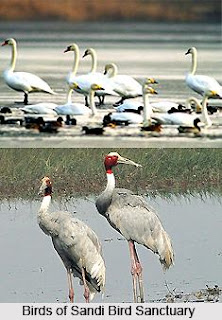At a Glance
One of the finest bird parks in the world, Bharatpur Bird Sanctuary also known as Keoladeo Ghana National Park is a reserve that offers protection to faunal species as well. Keoladeo, the name derives from an ancient Hindu temple, devoted to Lord Shiva, which stands at the centre of the park. 'Ghana' means dense, referring to the thick forest, which used to cover the area. Nesting indigenous water- birds as well as migratory water birds and waterside birds, this sanctuary is also inhabited by Sambar, Chital, Nilgai and Boar.
While many of India's parks have been developed from the hunting preserves of princely India, Keoladeo, popularly known as Bharatpur Wildlife Sanctuary, is perhaps the only case where the habitat has been created by a maharaja. In earlier times, Bharatpur town used to be flooded regularly every monsoon. In 1760, an earthen dam (Ajan Dam) was constructed, to save the town, from this annual vagary of nature. The depression created by extraction of soil for the dam was cleared and this became the Bharatpur Lake.
At the beginning of this century, this lake was developed, and was divided into several portions. A system of small dams, dykes, sluice gates, etc., was created to control water level in different sections. This became the hunting preserve of the Bharatpur royalty, and one of the best duck - shooting wetlands in the world. Hunting was prohibited by mid-60s. The area was declared a national park on 10 March 1982, and accepted as a World Heritage Site in December 1985.
Climate & Rainfall
Bharatpur is located on the fringes of the Thar Desert. This marshy land has very warm climate. Summers are invariably hot and winters are not very cold. The temperature ranges from a maximum of 48°C in summers (May and June) to around 5°C in winters (December to February).Carry light cottons during summers and woolens during winters. Rainfall is less but sufficient.
Flora
The term 'Ghana' means dense, referring to the thick forest, which used to cover the area. The principal vegetation types are tropical dry deciduous trees, intermixed with dry grassland in areas where forest has been tainted. Apart from the artificially managed marshes; much of the area is covered by medium-sized trees and shrubs.
The north east area of the park is mostly dominated by jamun (Syzygium cumini), babul (Acacia nilotica) and kadam (Mitragyna parvifolia). The open woodland is mostly babul with a little amount of ber and kandi. Ber and kair dominates the Scrublands.
Piloo (Salvadora persica) are also present in the park and happens to be only woody plants found in saline soil. The aquatic vegetation is rich and provides food source for waterfowls.
Fauna
The major attractions of tourists visiting the park are the numerous migratory birds, which come from as far away as Siberia and Central Asia and spend their winters in Bharatpur, before returning to their breeding grounds. Migratory birds at Bharatpur bird sanctuary include, several species of Cranes, Pelicans, Geese, Ducks, Eagles, Hawks, Shanks, Stints, Wagtails, Warblers, Wheatears, Flycatchers, Buntings, Larks and Pipits, etc.
Best Time to Visit
Bharatpur Wildlife Sanctuary is open throughout the year; still the ideal visiting months are from August-November for resident breeding birds and October- February for migrant birds. . #bharat_archives #india #mohitness#freelance_talents #bharatpur







